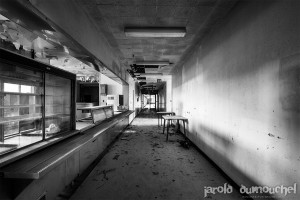Despite the many changes made to the building by the Negro community center, it is clear that the original building was a church. Plans are signed by Sidney Rose Badgley (1850-1917), an architect from Ste.Catherine,...
The Shelburne abandoned Youth Centre
Physical and sexual assault and other nightmares
* * * * *
UPDATE - Message from the owner: this facility is no longer abandoned and will be a regularly used Airsoft field for local groups that someone could be injured. This means that anyone coming on to the property to take photographs (thinking it's abandoned) could be seriously injured or permanently lose their eyesight if they get hit in the eyes.
* * * * *
Although Shelburne Youth Centre opens in 1948, the origins of the penitentiary institution come from as far back as 1865 when is founded the Halifax Industrial School for Boys. In 1947, when the funds run out for this Protestant institution, the provincial government announced, to the surprise of all, the construction of Shelburne center located more than 220 kilometers southeast of Halifax.
If the primary goal of such a removal was justified by the desire to keep these offenders off the vices of the capital, the main collateral damage was to create a considerable distance between them and their parents who can not afford to visit their kids as often as they wanted.
Thus, in the years 1955, they are about 70 boys to live on the campus. Girls will be admitted in 1985, after the closure of youth center for girls in Truro.
The campus is large and covers a vast territory. In addition to the seven dormitories and classrooms, we find among others a workshop, two libraries, a chapel, a large gym (who looks like a arena), amphitheater and more. Besides, if before 1960, it housed the residents in old military barracks dating from World War II, the facilities will be upgraded several times over the years.
Physical and sexual assault and other nightmares
In September 1948, at a time when force could be used to correct a child, we could read in the policies of the Nova Scotia School for Boys (former name of Shelburne boys Centre):
Supervisors are not to strike boys with anything except the regularly prescribed strap and this should be rigidly enforced. ... Corporal punishment is administered by the supervisors who have trouble with the boy. He must do it after consulting with the Principal. ... It must be done in the presence of at least two supervisors and must be done with only the prescribed strap. A written report must be submitted by the supervisor who had the difficulty with the boy. ... A boy is not to be struck with the hand or other instrument unless in self-defence. Corporal punishment should come within a reasonable time after misconduct and should not be administered when a supervisor is mad or annoyed.
Over the years, many boys will complain of abuse by the institution's staff. They say: corporal punishments are given on a regular base and abusive ways are used often. So much so that by the end of 1970, a committee was formed to investigate the practices of the institution and to make recommendations to the government. It will be determined in 1980 that only force in exceptional circumstances will be tolerated. Corporal punishment is therefore prohibited.
Yet this is the tip of the iceberg. Sexual abuse allegations will be added to the list of mistreatment of inmates. Nothing new, knowing that in the 1960s, many horror stories were floating around the center, such a loan rain cloud ready to unleash his anger.
In February 1986, three residents accuse members of the institution of having sexually assaulted them. After the police investigation, the charges are eventually dropped for nebulous reasons (the three complainants were not presented in court).
One of the most notorious institution's executioners was Patrick MacDougall, an employee who worked from September 1959 to June 1975 and having had 877 boys under his charge. Having made several sexual abuses on boys, he was finally declared guilty in 1993 to five counts of indecent assault that results in a sentence of six years in prison.
Encouraged by the first denunciations, new victims will find the courage to denounce MacDougall in the months that follow. Thus, the latter will see its prison sentence stretched to 11 years.
Two other executioners will also convicted following revelations of new victims, while others were acquitted.
A fund for victims of $ 61 million was also created.
Today, the center is desert and plagued some isolated acts of vandalism. Still, he remains guarded by the landowner and some openings are regularly closed to offer old buildings a little quiet.
Related content
Built in 1949 on the shores of the Bedford Basin in Halifax, Shannon Park is a former site of the Department of National Defence (DND) that stretches on over 96.5 acres (38.8 hectares). While the site was gradually abandoned at the turn of 2000,...
Located in the Eastern Townships, this loyalist manor house with its chic style reminiscent of the homes in New England. It seems abandoned for quite some time, although it is remarkably well preserved. There has been some vandalism in the rooms...
Beyond the tourist beauties we are used to see when we visit the Gaspesie, it can be found hundreds of abandoned houses that show those old days when the region had not yet suffered the wrath of the rural exodus.
If the economy of the...




















